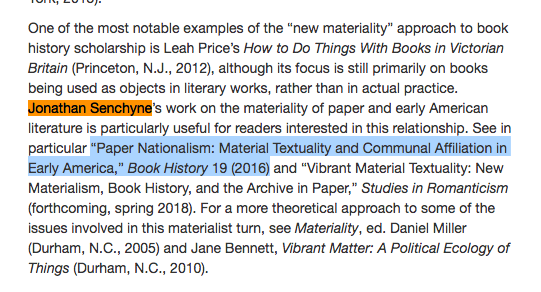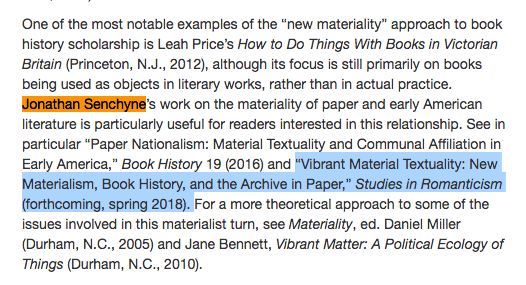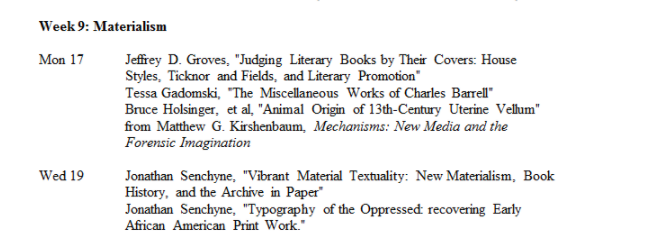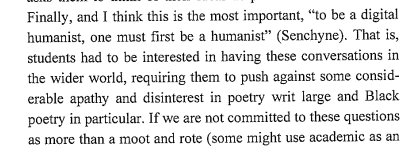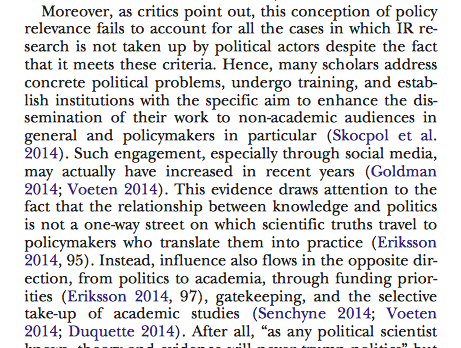Quantifiable data about scholarly research output and the citation of one’s research by others is increasingly important in the administrative assessment and evaluation of faculty and departments in higher education. At the same time, however, much of the work of compiling bibliometrics is done by robots looking for data structured in certain ways, or by private firms using “black box” procedures with inaccurate results. Standard bibliometrical tools tend not to be very accurate or useful in capturing the practices and cultures of humanities research. This is my attempt to keep track of a fuller range of citations to my work in a way that is more accurate than Google Scholar or other bibliometric programs. Also included at the bottom of the page are instances of my research being included in syllabi and formal citations of my non-peer-reviewed output.
Citations of Peer-Reviewed Research Jonathan Senchyne, “Bottles of Ink and Reams of Paper: Clotel, Racialization, and the Material Culture of Print” Early African American Print Culture eds. Lara Langer Cohen and Jordan Alexander Stein, Philadelphia: University of Pennsylvania Press, 2012, 140-158.
- Katy L. Chiles, “Review of Early African American Print Culture.” Modern Language Review 109.3 (July 2014), 783-784.

- Sarah N. Roth, “Review of Early African American Print Culture” Journal of American History 100.1 (June 2013), 198-199.

- Jacob Crane, Hazardous Crossings: The Transatlantic Figure in American Print, 1784-1855. Dissertation, Tufts University, 2014, 167.

- Dalila Scruggs, The love of liberty has brought us here”: The American Colonization Society and the imaging of African-American settlers in Liberia, Dissertation, Harvard University, 2010, 218.

- Caroline Bressley, Empire, Race and the Politics of Anti-Caste, London: Bloomsbury, 2013, 20.

- Alex W. Black, “Abolitionism’s Resonant Bodies: The Realization of African American Performance” American Quarterly 63.3 (2011), 619-639.


- Eric M. Curry, Sutton E. Griggs and the African American Literary Tradition of Pamphleteering. Dissertation. University of Maryland-College Park. 2015. 137-138.

- Katy Chiles, “From Writing the Slave Self to Querying the Human: The First Twenty-Five Years of The Signifying Monkey” Early American Literature 50.3 (2015), 882, 890.


- Joycelyn K. Moody, “Tactical Lines in Three Black Women’s Visual Portraits, 1773–1849” a/b: Auto/Biography Studies 30.1 (March 2015), 76, 86, 91, 94, 97.




 Reprinted in Auto/Biography in the Americas: Relational Lives edited by Ricia A. Chansky, (New York: Routledge, 2016).
Reprinted in Auto/Biography in the Americas: Relational Lives edited by Ricia A. Chansky, (New York: Routledge, 2016).


- Miles Grier, “Inkface: The Slave Stigma in England’s Early Imperial Imagination” Scripturalizing the Human: The Written as the Political ed. Vincent L. Wimbush, New York, Routledge, 2015, 200, 213.


- Beth Corzo-Duchart, “Paper Girls: Gender and Materiality in Turn-of-the-Century Outdoor Advertising” Feminist Media Histories 1.3 (Summer 2015), 41, 61.


- Brigitte Fielder, “Visualizing Racial Mixture and Movement: Music, Notation, Illustration” J19: The Journal of Nineteenth-Century Americanists 3.1 (Spring 2015), 155.

- Danielle Skeehan, “Texts and Textiles: Material Economies in the Early Atlantic” Economic History’s Many Muses: Fourteenth Annual Conference of the Program in Early American Economy and Society. October 24-25, 2014. Library Company of Philadelphia. 8, 14.




- Douglas A. Jones, Jr. “Early Black American Writing and the Making of a Literature” Early American Literature, 49.2 (2014), 553-569.

- Jordan A. Stein, ““Queering Abolition,” Situation Critical! Critique, Theory, and Early American Studies conference,McNeil Center for Early American Studies, University of Pennsylvania. 31 March-2 April 2016. 6.

 16. Isaac Fosl-Van Wyke, Review of “I can’t breathe (Eric Garner). New York: antoine lefebvre editions. 2015” Journal of Artists’ Books 39 (Spring 2016) 52.
16. Isaac Fosl-Van Wyke, Review of “I can’t breathe (Eric Garner). New York: antoine lefebvre editions. 2015” Journal of Artists’ Books 39 (Spring 2016) 52.  17. Manisha Sinha, The Slave’s Cause: A History of Abolition (New Haven: Yale University Press, 2016), 704.
17. Manisha Sinha, The Slave’s Cause: A History of Abolition (New Haven: Yale University Press, 2016), 704. 18. Jesse Ryan Erickson, Rethinking the Library Response to Black Literacy, Dissertation, UCLA, 2016. 225-226.
18. Jesse Ryan Erickson, Rethinking the Library Response to Black Literacy, Dissertation, UCLA, 2016. 225-226. 

 19. Britt Rusert, “From Black Lit to Black Print: The Return to the Archive in African American Literary Studies” American Quarterly 68.4 (2016) 997.
19. Britt Rusert, “From Black Lit to Black Print: The Return to the Archive in African American Literary Studies” American Quarterly 68.4 (2016) 997.  20. Danielle Skeehan, “Texts and Textiles: Commercial Poetics and Material Economies in the Early Atlantic” Journal of the Early Republic 36.4 (Winter 2016) 690-1, 697.
20. Danielle Skeehan, “Texts and Textiles: Commercial Poetics and Material Economies in the Early Atlantic” Journal of the Early Republic 36.4 (Winter 2016) 690-1, 697.
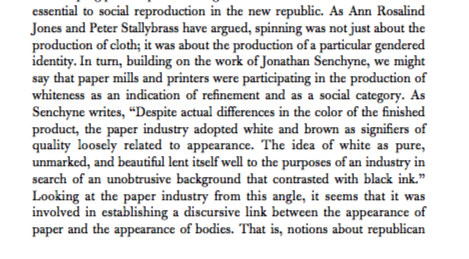


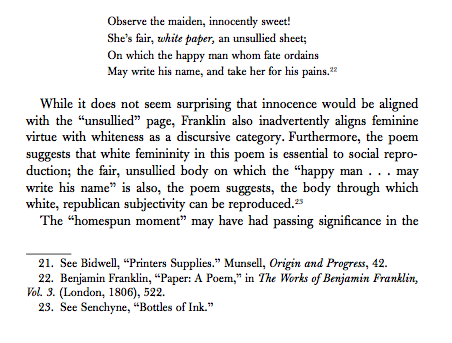 21. Sonja R. West, “The ‘Press,’ Then & Now” Ohio State Law Journal 77.1 (2016), 80.
21. Sonja R. West, “The ‘Press,’ Then & Now” Ohio State Law Journal 77.1 (2016), 80. 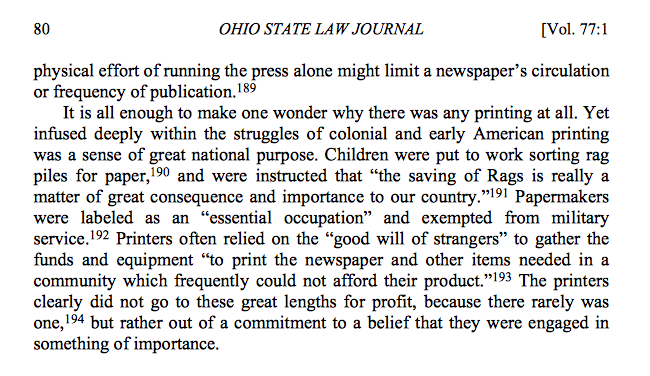
 22. Joycelyn K. Moody, “Introduction” to Frances Harriet Whipple with Elleanor Eldridge, Memoirs of Elleanor Eldridge ed. Joycelyn K. Moody (Morgantown: West Virginia University Press, 2014), 42, 76.
22. Joycelyn K. Moody, “Introduction” to Frances Harriet Whipple with Elleanor Eldridge, Memoirs of Elleanor Eldridge ed. Joycelyn K. Moody (Morgantown: West Virginia University Press, 2014), 42, 76. 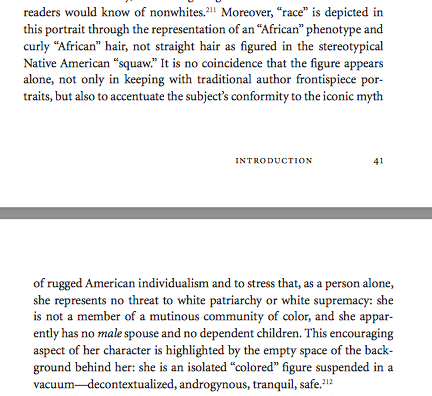
 23. Marie Buck, Weird Propaganda: Texts of Black Power and Women’s Liberation Movements. Dissertation, Wayne State University, 2017.
23. Marie Buck, Weird Propaganda: Texts of Black Power and Women’s Liberation Movements. Dissertation, Wayne State University, 2017. 

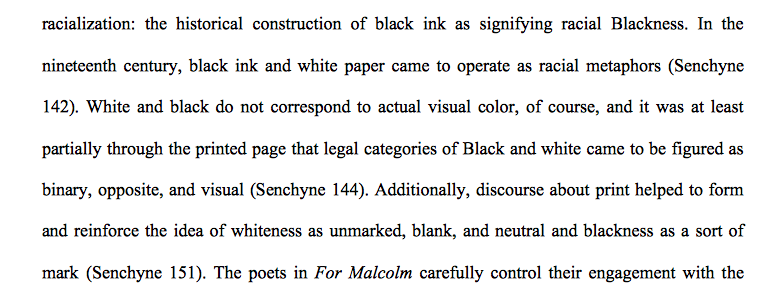
 24. Naomi Greyser, On Sympathetic Grounds: Race, Gender, and Affective Geographies in Nineteenth-Century North America (New York: Oxford University Press, 2017) 240.
24. Naomi Greyser, On Sympathetic Grounds: Race, Gender, and Affective Geographies in Nineteenth-Century North America (New York: Oxford University Press, 2017) 240.  25. Katie McGettigan, Herman Melville: Modernity and the Material Text (Durham, NH: University of New Hampshire Press, 2017) 242.
25. Katie McGettigan, Herman Melville: Modernity and the Material Text (Durham, NH: University of New Hampshire Press, 2017) 242. 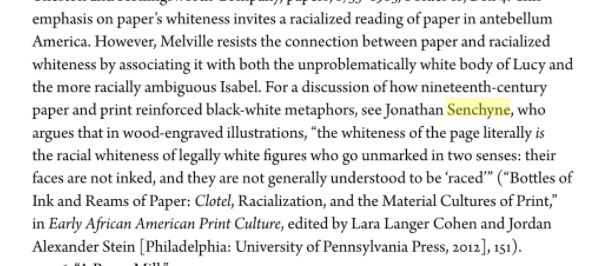 26. Jonathan Flatley, Like Andy Warhol (Chicago: University of Chicago Press, 2017) 196.
26. Jonathan Flatley, Like Andy Warhol (Chicago: University of Chicago Press, 2017) 196.
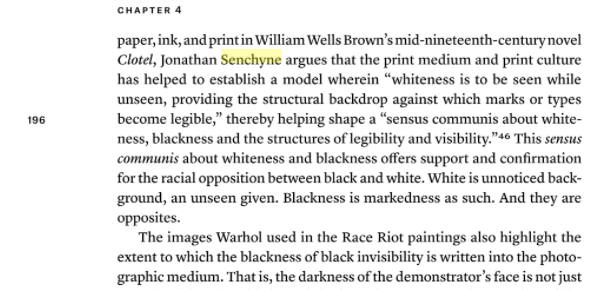
 27. Jeffrey Michael Mikala, Print On Demand: Stereotyping And Electrotyping In The United States Printing Trades And Publishing Industry, 1812-1860. Dissertation. University of South Carolina, 2018. 216-217.
27. Jeffrey Michael Mikala, Print On Demand: Stereotyping And Electrotyping In The United States Printing Trades And Publishing Industry, 1812-1860. Dissertation. University of South Carolina, 2018. 216-217. 
 28. Samuel Arrowsmith Turner, Red Letters, White Paper, Black Ink: Race, Writing, Colors, and Characters in 1850s America. Dissertation. University of Virginia, 2013. 302, 328, 332, 339, 345.
28. Samuel Arrowsmith Turner, Red Letters, White Paper, Black Ink: Race, Writing, Colors, and Characters in 1850s America. Dissertation. University of Virginia, 2013. 302, 328, 332, 339, 345. 


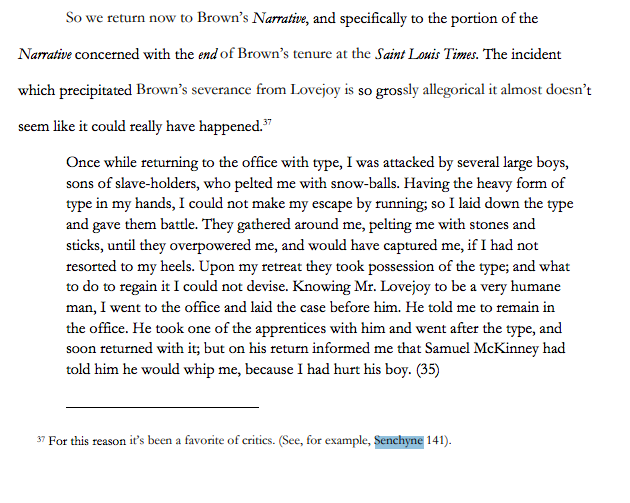
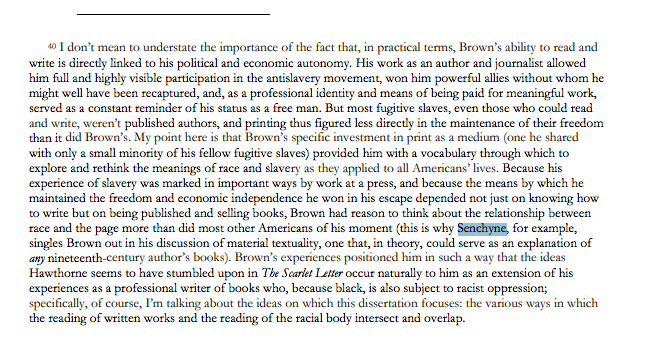
Jonathan Senchyne, “Paper Nationalism: Material Textuality and Communal Affiliation in Early America,” Book History 19 (2016) 66-85.
-
- Paul Erickson, “The Business of Building Books” Common-place: The Journal of Early American Life Vol. 17 No. 4, Summer 2017.
- Miranda Burgess, “Jane Austen on Paper,” European Romantic Review, 29:3 (2018) 365-375.
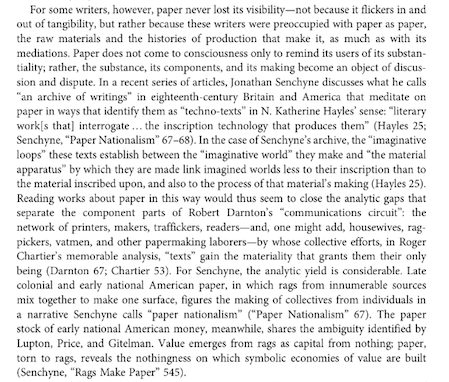

- Mark Vareschi, Everywhere and Nowhere: Anonymity and Mediation in Eighteenth-Century Britain (Minneapolis: University of Minnesota Press, 2018)
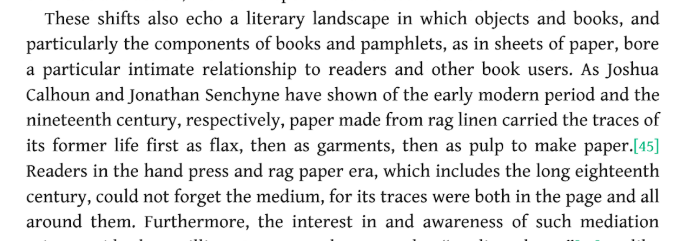

- Barbara Hochman, “Filling in Blanks: Nella Larsen’s Application to Library School” PMLA 133.5 (2018) 1172-1190.


- Roar Lishaugen and Jirina Smejkalova, “Reading East of the Berlin Wall” PMLA 134.1 (2019) .
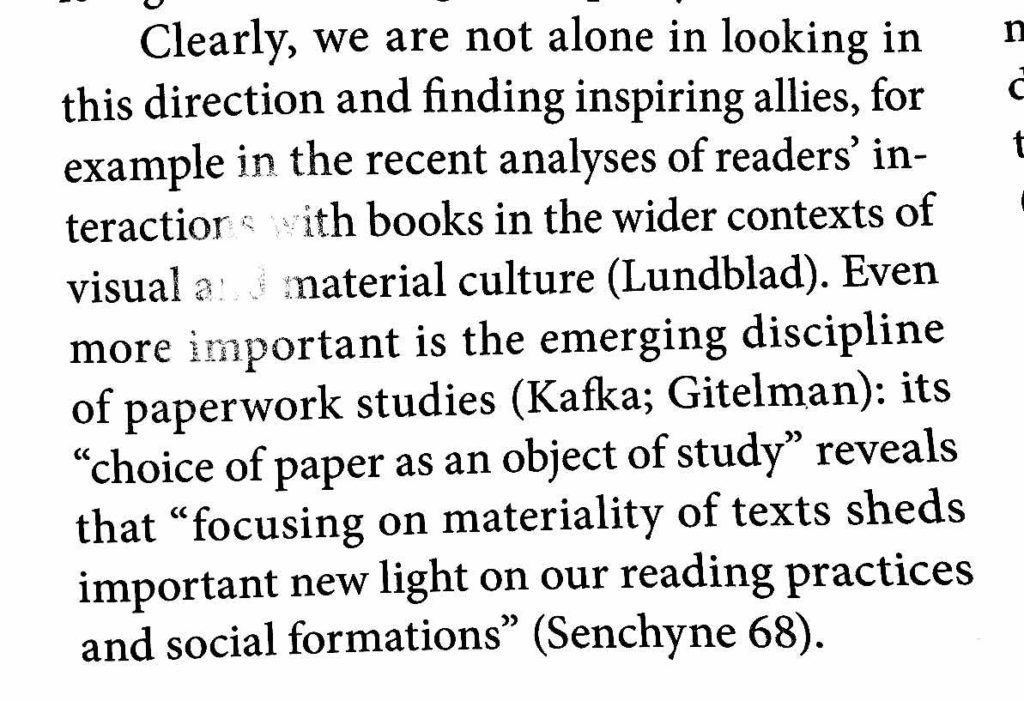

Jonathan Senchyne, “Rags Make Paper, Paper Makes Money: Material Texts and the Creation of Capital” Technology and Culture 58.2 (April 2017) 545-555.
- Miranda Burgess, “Jane Austen on Paper,” European Romantic Review, 29:3 (2018) 365-375.


2. Thora Brylowe, “Paper and the poor: Romantic media ecologies and the Bank Restriction Act of 1797” Literature Compass. 2019;e12506




Jonathan Senchyne, “Vibrant Material Textuality: New Materialism, Book History, and Archive in Paper” Studies in Romanticism 57.1 (Spring 2018) 67-85.
-
- Thora Brylowe, “Paper and the poor: Romantic media ecologies and the Bank Restriction Act of 1797” Literature Compass. 2019;e12506




-
- Paul Erickson, “The Business of Building Books” Common-place: The Journal of Early American Life Vol. 17 No. 4, Summer 2017.
- Sonia Hazard, “Thing.” Early American Studies 16.4 (Fall 2018) 792-800.

- Jamie M. Bolker. “Dreiser’s Paper and the Bureaucratization of Identity.” Book History 21 (2018): 317-342.

Jonathan Senchyne, “Between Knowledge and Metaknowledge: Shifting Disciplinary Borders in Digital Humanities and Library and Information Studies” Debates in the Digital Humanities 2016, Eds. Matthew K. Gold and Lauren F. Klein (Minneapolis: University of Minnesota Press, 2016) 368-376.
-
Heidi L.M. Jacobs and Cal Murgu, “Questioning the Past and Possible Futures: Digital Historiography and Critical Librarianship” Journal of Critical Library and Information Studies 1.1 (2017) 3.
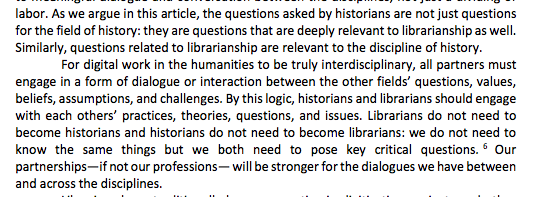

- Daniel G. Tracy and Elizabeth Massa Hoiem, “Teaching Digital Humanities Tools at a Distance: A Librarian-Instructor Partnership Integrating Scalar into a Graduate Distance Course.” At the Helm: Leading Transformation: The Proceedings of the ACRL 2017 Conference March 22–25, 2017. Ed. Dawn M. Mueller. Association of College and Research Libraries, a division of the American Library Association, 2017. 706.


- Chris Alen Sula, S. E. Hackney, Phillip Cunningham, “A Survey of Digital Humanities Programs” The Journal of Interactive Technology and Pedagogy Issue 11 (May 2017). [LINK]


- Bogumila Suwara and Andrzej Adamski, “”New forms of knowledge design and their presence/absence in Central Europe” World Literature Studies Issue 3 (2017) 98-110.

 5. Katherine Howard, The Unique Role and Value of Information Professionals in Special Libraries (Canberra: The Australian Library and Information Association, 2017), 5.
5. Katherine Howard, The Unique Role and Value of Information Professionals in Special Libraries (Canberra: The Australian Library and Information Association, 2017), 5. 
 6. Alex H. Poole and Deborah A. Garwood, ““Natural Allies”: Librarians, Archivists, and Big Data in International Digital Humanities Project Work” The Journal of Documentation (February 2018).
6. Alex H. Poole and Deborah A. Garwood, ““Natural Allies”: Librarians, Archivists, and Big Data in International Digital Humanities Project Work” The Journal of Documentation (February 2018).


Jonathan Senchyne, “Print Culture” Henry David Thoreau in Context, Ed. James S. Finley (Cambridge: Cambridge University Press, 2017) 110-119. View 1 Citation Brigitte Bailey. “Fuller, the Dial, the Tribune, and Periodical Print Culture.” South Central Review 35, no. 3 (2018): 89-102. 
Jonathan Senchyne, Our Paper Allegories: Intimacy, Publicity, and Material Textuality in Colonial and Antebellum American Literature. Dissertation, Cornell University, 2012. View 3 Citations
- Jordan Alexander Stein, “Herman Melville’s Love Letters” ELH (English Literary History), 85.1 (Spring 2018), 129.


- Caleb Smith, “Editor’s Note on the Text” in Austin Reed, The Life and Adventures of a Haunted Convict ed. Caleb Smith (New York: Random House, 2016) , 258.

- David S. Shields, “The American Antiquarian Society, 1812-2012: A Bicentennial History by Philip F. Gura (review)” Early American Literature 48.1 (2013), 264-265.

Peer-Reviewed Research Assigned in Courses
“Bottles of Ink and Reams of Paper: Clotel, Racialization, and the Material Culture of Print” Early African American Print Culture eds. Lara Langer Cohen and Jordan Alexander Stein, Philadelphia: University of Pennsylvania Press, 2012. View 4 Syllabus Assignments
- Jenny Davidson, “Literary Texts, Critical Methods” Fall 2014, Columbia University English Department
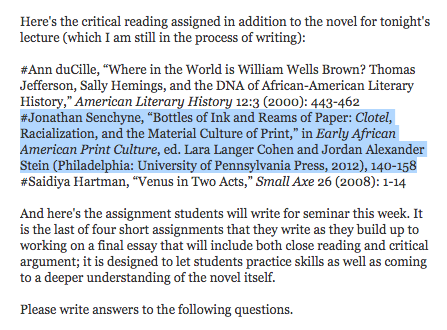
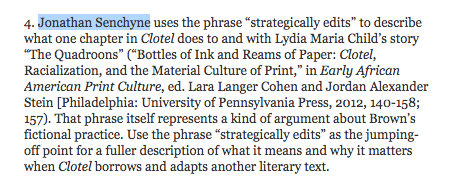
- Ryan Cordell and Erika Boeckeler, “History of Books” Fall 2016, Northeastern University English Department

- Joycelyn Moody, “ENG 6063/ 7063 AFRICAN AMERICAN PRINT CULTURE STUDIES” Fall 2012, University of Texas-San Antonio English Department

- Zachary Lesser, “English 574 / Comparative Literature 580 / History 574: Introduction to Bibliography from Gutenberg to Google Books” Spring 2015, University of Pennsylvania English Department
“Between Knowledge and Metaknowledge: Shifting Disciplinary Borders in Digital Humanities and Library and Information Studies” Debates in the Digital Humanities 2016, eds. Matthew K. Gold and Lauren F. Kline, University of Minnesota Press, 2016. View 8 Syllabus Assignments
- Patrick Williams, “IST600: Digital Humanities for Librarians, Archivists, & Cultural Heritage Workers,” Spring 2019 Syracuse University iSchool
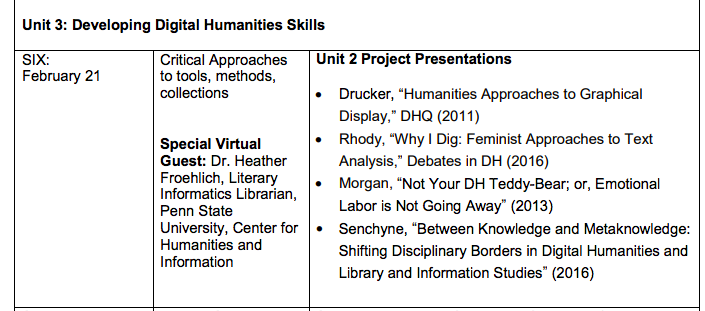
- Tanya E. Clement, “INF 383H: Introduction to Digital Humanities,” Fall 2016 University of Texas-Austin iSchool
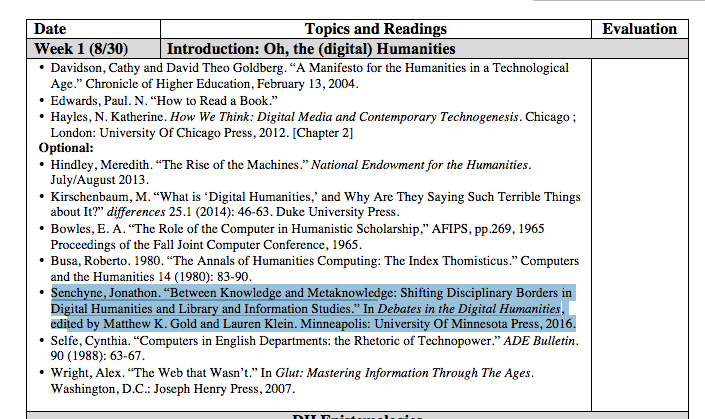
- Tanya E. Clement, “INF 383H: Introduction to Digital Humanities,” Spring 2017 University of Texas-Austin iSchool

- Ted Underwood, “LIS590DH: Digital Humanities” Fall 2016. University of Illinois, Urbana-Champaign GSLIS

- Francisco Carlos Paletta and Ivan Claudio Pereira Siqueira, “Digital Humanities,” University of Sao Paolo, Brazil.
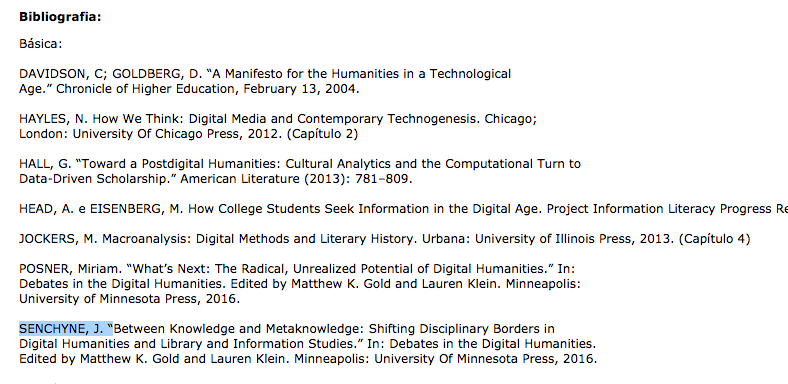
- Marcell Sebők, Jessie Labov, Tamás Kiss, “MEDS 5202: Mining History: Digital Practices in Humanities Research,” Spring 2018. Central European University.
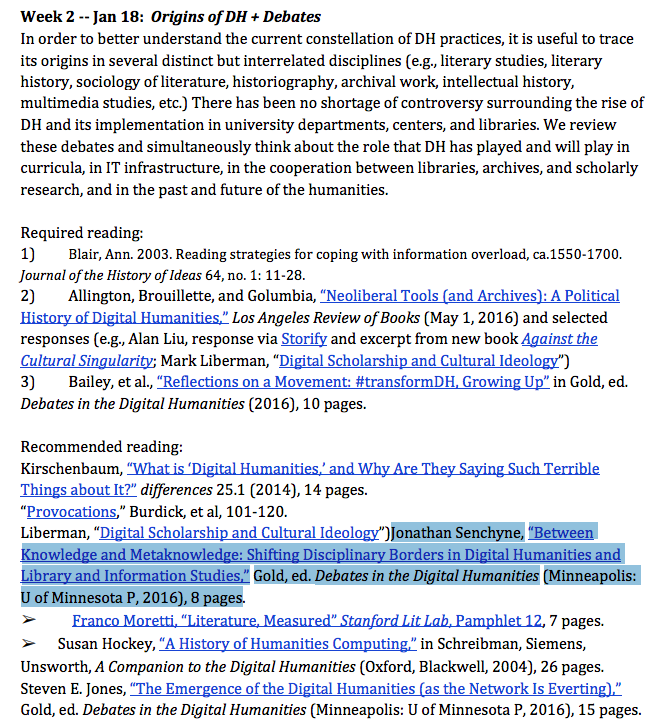
- Emily Kugler. “ENGG 220: Restoration and 18th-Century English Literature” English Department, Howard University, 2018.
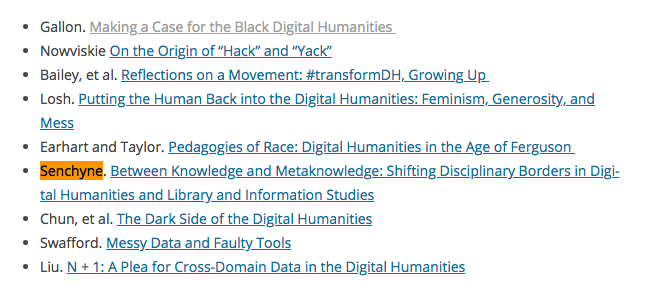
- Katherine Pandora, “History of Science 4613 and 5613: Issues and Methods in the Digital Humanities” History of Science Department, University of Oklahoma, 2018.
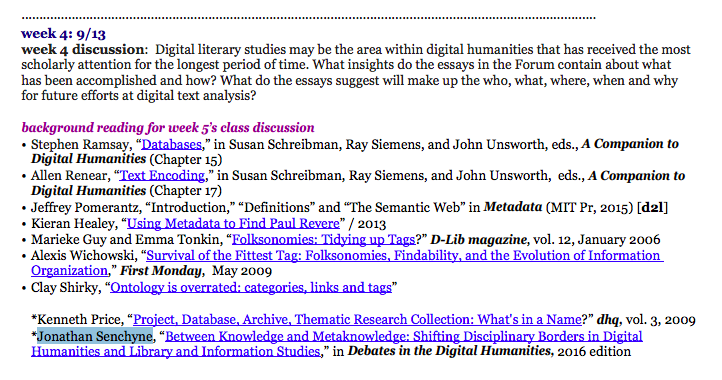
Jonathan Senchyne, “Paper Nationalism: Material Textuality and Communal Affiliation in Early America” Book History Vol 19 (2016) 66-85. View 5 Syllabus Assignments
- Matthew Kirschenbaum, “ENGL 759C BookLab: How to Do Things with Books” Spring 2019, University of Maryland.

- Ryan Cordell, “English 7370: Reading Machines: Technology and the Book” Spring 2019, Northeastern University.
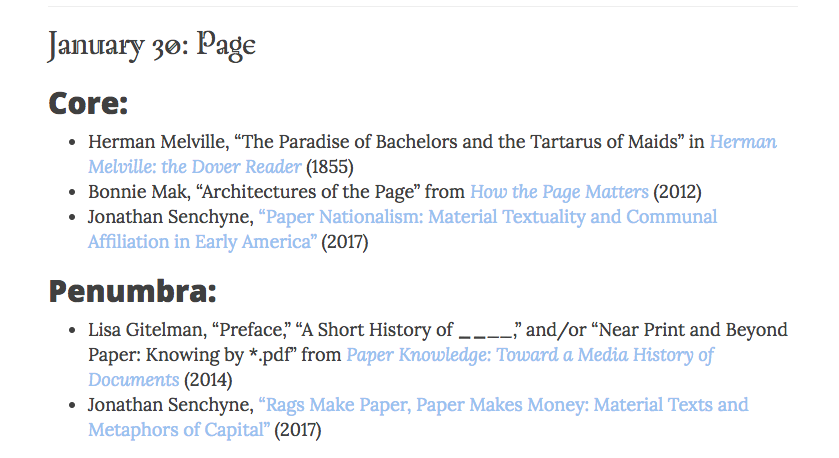
- Ross Tangedal, “ENGL 389: Book History Authorship, Print Culture, & Bibliography” Spring 2019, University of Wisconsin-Stevens Point.

- Mark Mattes, “English 599: A Reintroduction to Books” Spring 2017, University of Louisville.
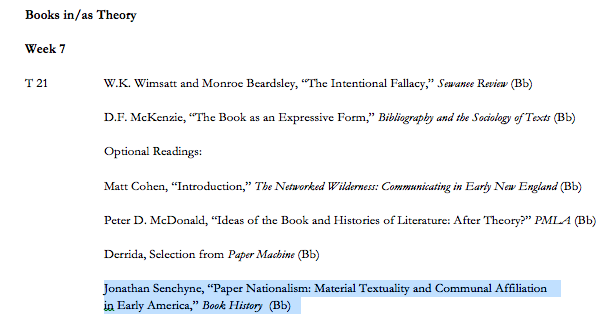
- Melissa Helquist and Lisa Bickmore, “The Book: Material Histories and Digital Futures” 2018 NEH Summer Institute for College and University Teachers, Salt Lake City Community College.
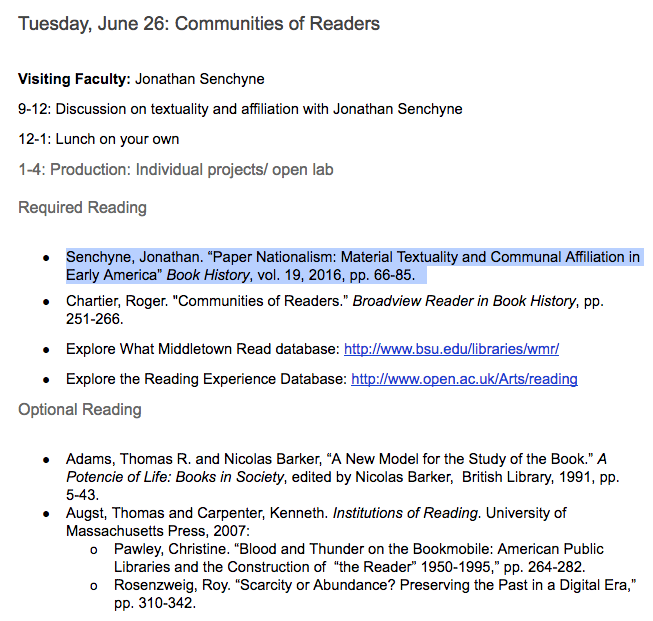
Jonathan Senchyne, “Vibrant Material Textuality: New Materialism, Book History, and Archive in Paper” Studies in Romanticism 57.1 (Spring 2018) 67-85. View 1 Syllabus Assignment
- Leon Jackson, “ENGL 756: The History of the Book in America” Fall 2016, University of South Carolina English Department
Jonathan Senchyne, “Under Pressure: Recovering Early African American Print Work” (forthcoming, Arizona Quarterly) View 1 Syllabus Assignment
Jonathan Senchyne, “Rags Make Paper, Paper Makes Money: Material Texts and Metaphors of Capital” Technology and Culture 58.2 (2017) 545-555. View 2 Syllabus Assignments
- Matthew Kirschenbaum, “ENGL 759C BookLab: How to Do Things with Books Spring 2019, University of Maryland.

- Ryan Cordell, “English 7370: Reading Machines: Technology and the Book” Spring 2019, Northeastern University.

Citations of non-peer-reviewed writing Jonathan Senchyne, “An Introduction to the Digital Humanities for Librarians” UW-Madison SLIS Continuing Studies Webcast, May 2014. View 1 Citation
- Joe Eschleman and Kristin Eschleman, “Innovation and Cooperative Ventures” Librarians and Instructional Designers: Collaboration and Innovation (Chicago: ALA Editions, American Library Association) 2016. 108.

![]() Jonathan Senchyne, “Reading Surfaces: Paper, iPhones, and Sentimentality” Bates College, Lewiston Maine. Invited Talk, 28 April 2014. View 1 Citation
Jonathan Senchyne, “Reading Surfaces: Paper, iPhones, and Sentimentality” Bates College, Lewiston Maine. Invited Talk, 28 April 2014. View 1 Citation
- Theri A. Pickens, “Hashtag Black Poetry” Journal of Ethnic American Literature 4 (2014) 19, 25.
- Beate Jahn, “Theorizing the Political Relevance of International Relations Theory” International Studies Quarterly (August 2016) 3, 13.
- Peter Coviello, Should I Go To Grad School? 41 Answers to an Impossible Question eds. Jessica Loudis, Bošco Blagojević, John Arthur Peetz, Allison Rodman, New York: Bloomsbury, 2014. 106.

- Jules Boykoff, “Poets as Experimental Geographers: Mark Nowak, Kaia Sand, and the Re-composition of Political-Historical Space” Placing Poetry, eds. Ian Davidson and Zoë Skoulding, Amsterdam: Rodopi, 2012. 231, 232, 235.

